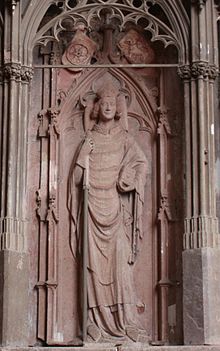Gerlach of Nassau
Gerlach von Nassau (* 1322 in Idstein ; † February 12, 1371 in Aschaffenburg ) was Archbishop of Mainz from 1346 until his death .
Life
Gerlach von Nassau was the son of Count Gerlach I of Nassau and his wife Agnes von Hessen († 1332), daughter of Heinrich the Younger (1265-1298), a son of Landgrave Heinrich I of Hesse (1244-1308). At the age of 14 he received from Pope Benedict XII. a benefice as a canon in Mainz. Between 1340 and 1344 he studied at the University of Bologna . In 1345 he became cathedral dean in Mainz .
Pope Clement VI put on April 7, 1346 the Archbishop of Mainz Heinrich III. von Virneburg in the context of disputes between Emperor Ludwig the Bavarian and the Curia . On April 26, 1346, Gerlach was ordained bishop in Avignon and he was named Heinrich's successor.
Gerlach supported Elector Baldwin of Luxembourg and helped Charles IV to be elected as Ludwig's anti-king . Since neither Ludwig the Bavarian nor Heinrich III. wanted to renounce his bishopric, the disputes over the Mainz diocese and the Roman-German royal throne continued. Only after Heinrich's death in December 1353 was Gerlach able to assume sole rule in Kurmainz . However, he had to take almost all previous Mainz possessions in Lower and Upper Hesse from the Landgraves of Hesse as fiefs ; only Fritzlar , Amöneburg and Naumburg remained in possession . This was the price for the military assistance that Landgrave Heinrich II had given him against Heinrich von Virneburg, whereby the heavy defeat that Landgrave Gerlach's rival had inflicted at Fritzlar in 1347 stands out.
In 1356 Gerlach took part in the court days of Nuremberg and Metz , where Charles IV's Golden Bull was drawn up. In it, the Archbishop of Mainz, as Arch Chancellor for the German part of the Holy Roman Empire, was given the chairmanship of the Electoral Assembly and the decisive, final vote in the election of the King .
To strengthen economic and political interests in the Middle Rhine, Gerlach formed a customs union with the Palatinate and Trier electors . In advance he tried to expand the power of the Electorate of Mainz by granting city privileges to various places, including Höchst am Main as an outpost against the competition from the Free Imperial City of Frankfurt am Main and Algensheim as an outpost to the Middle Rhine Valley.
Gerlach had appointed his nephew Adolf von Nassau as coadjutor during his lifetime . Thus Adolf was planned as Gerlach's successor on the Mainz electoral throne and bishopric. However, Gerlach's early death in February 1371 thwarted these plans. Adolf von Nassau did not become Archbishop of Mainz until 1381.
The grave of Gerlach von Nassau is located in the basilica of the Eberbach monastery in the Rheingau . The tombstone erected today shows the half-relief Gerlach in regalia with miter , crosier and book. It originally covered the crypt of a wall niche grave with canopy architecture, which stood free on three sides on the north wall of the choir. The moat is assigned to the so-called master of the Severi sarcophagus . In 1707 the grave had to give way to a monumental high altar in the course of the baroque redesign of the monastery under Abbot Michael Schnock . The bones of Gerlach from Nassau have since been in a wall niche behind the grave slab.
literature
- Hanno Hahn : The 'high grave' and the crypt of Gerlach von Nassau (died 1371) in the monastery church Eberbach i. Rhg. In: Nassauische Annalen, 65, 1954.
- Anton Ph. Brück : Gerlach of Nassau. In: New German Biography (NDB). Volume 6, Duncker & Humblot, Berlin 1964, ISBN 3-428-00187-7 , p. 293 ( digitized version ).
- Bernhard Hemmerle : Gerlach, Count of Nassau. In: Biographisch-Bibliographisches Kirchenlexikon (BBKL). Volume 23, Bautz, Nordhausen 2004, ISBN 3-88309-155-3 , Sp. 509-511.
- Theodor Lindner : Gerlach: Archbishop of Mainz . In: Allgemeine Deutsche Biographie (ADB). Volume 9, Duncker & Humblot, Leipzig 1879, pp. 5-7.
- Ellen Widder: Chancellor and law firms in the late Middle Ages. A histoire croisée princely administration in the south-west of the empire , Stuttgart 2016 (publications of the Commission for historical regional studies in Baden-Württemberg, series B: Research, 204), pp. 192–232, 256–271, 292–310, 508.
Web links
Remarks
- ↑ uncertain, according to Bibliographic Church Lexicon
- ^ Georg Dehio : Handbook of German Art Monuments - Hesse II: The Darmstadt District , Deutscher Kunstverlag Munich 2008, p. 423, ISBN 978-3422031173
- ↑ Yvonne Monsees: tombs in Kloster Eberbach , friends Kloster Eberbach eV 2009, p 98, ISBN 978-3-00-027060-4
| predecessor | Office | successor |
|---|---|---|
| Henry III. from Virneburg |
Elector Archbishop of Mainz 1346–1371 |
Johann von Luxemburg-Ligny |
| personal data | |
|---|---|
| SURNAME | Nassau, Gerlach from |
| BRIEF DESCRIPTION | Archbishop of Mainz |
| DATE OF BIRTH | 1322 |
| PLACE OF BIRTH | Idstein |
| DATE OF DEATH | February 12, 1371 |
| Place of death | Aschaffenburg |
